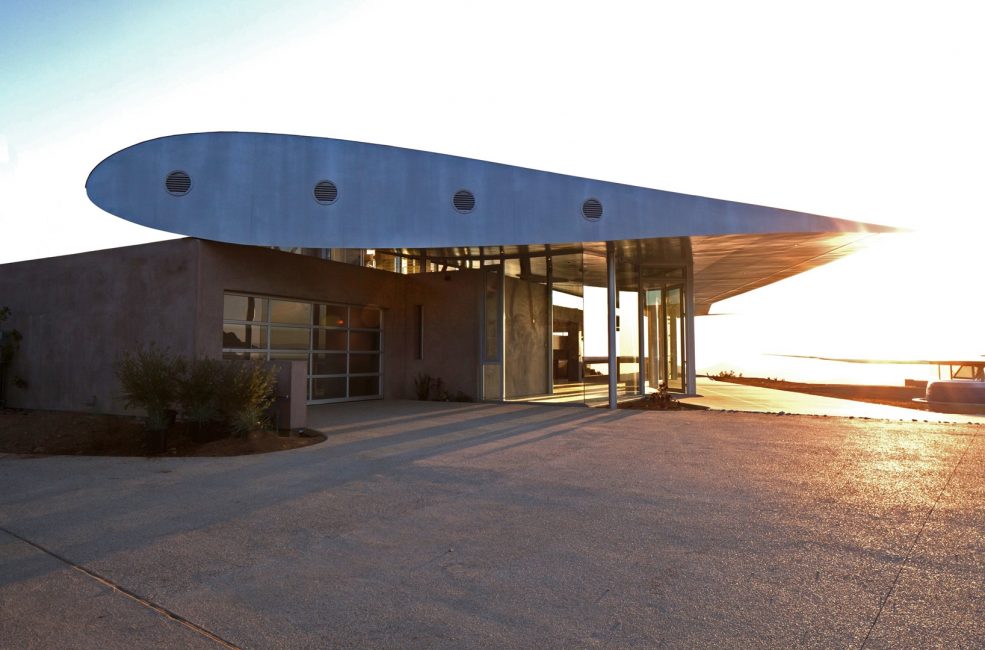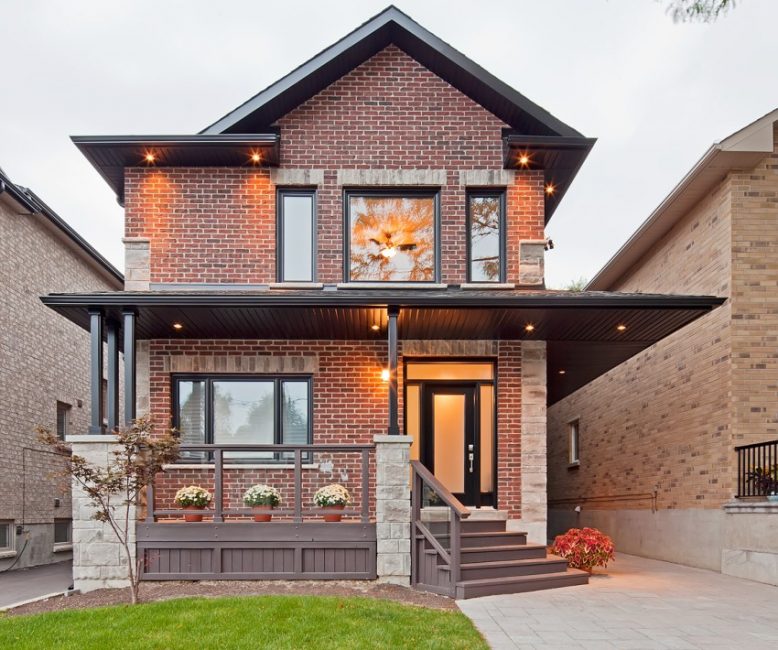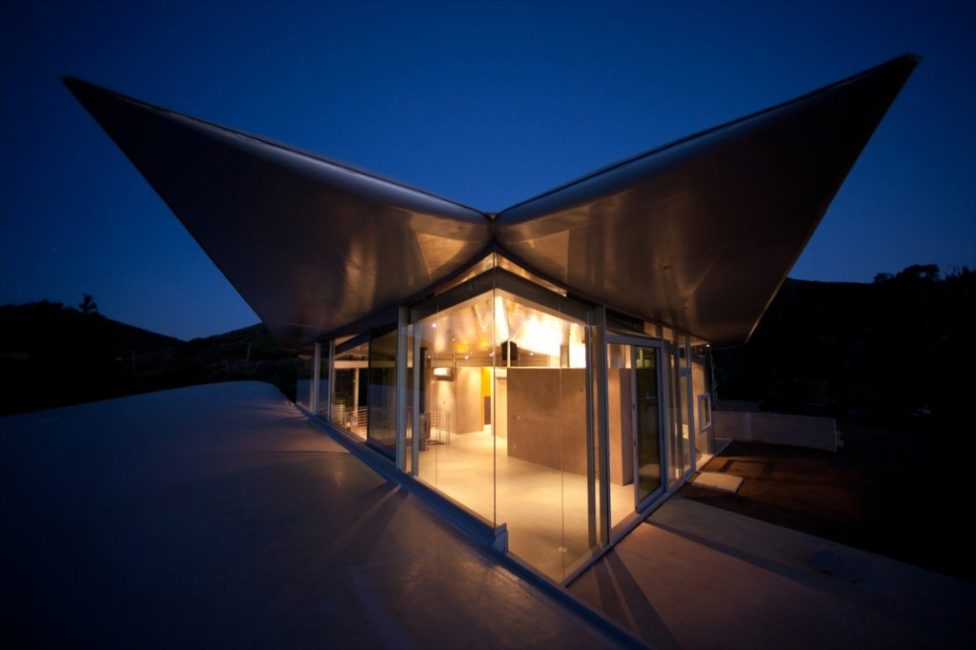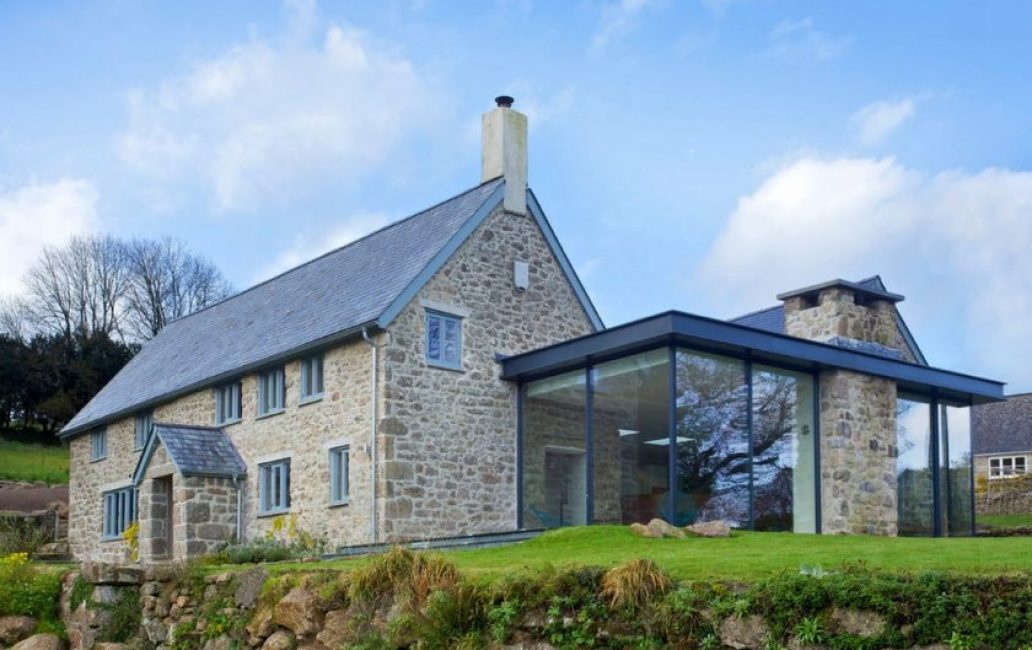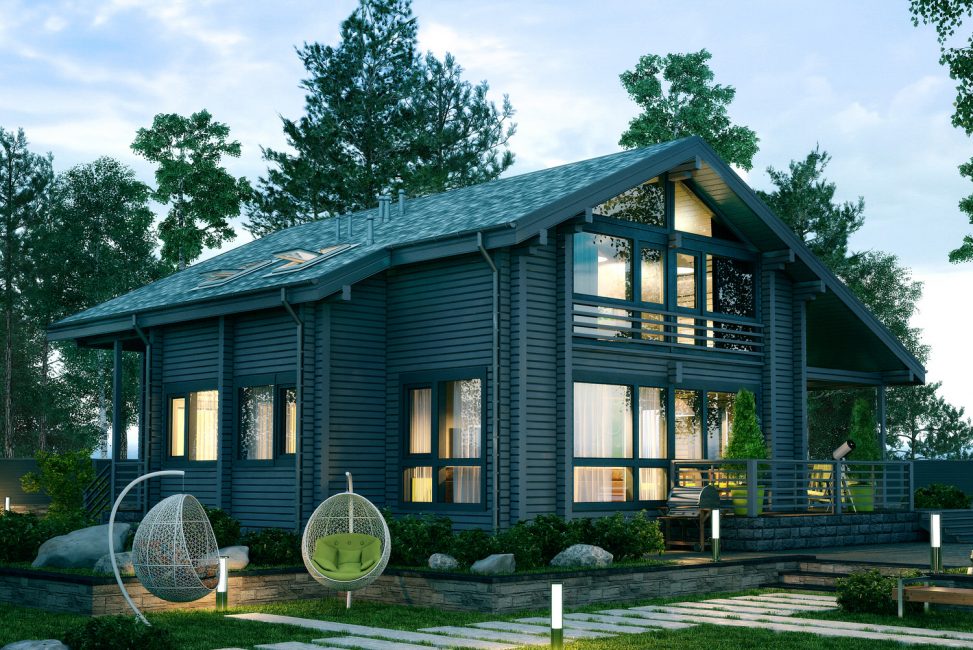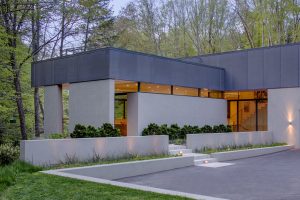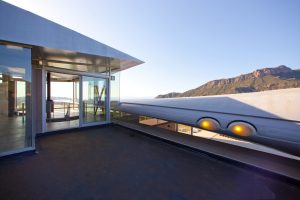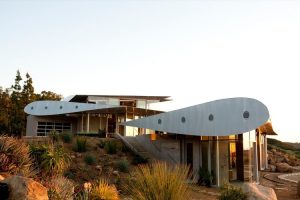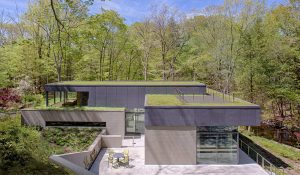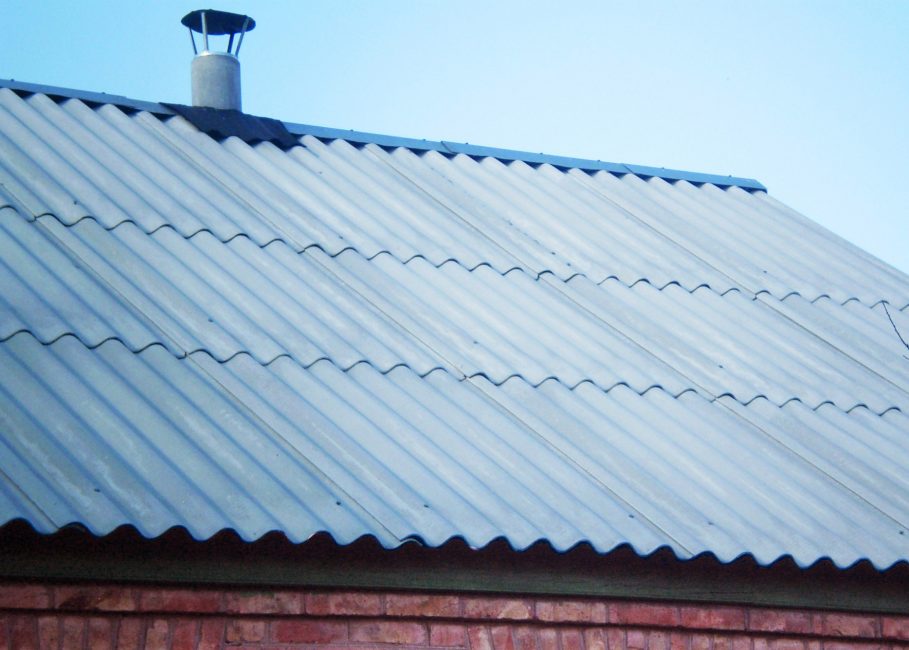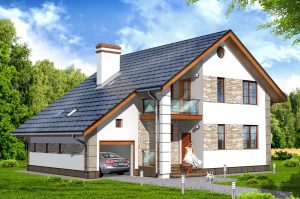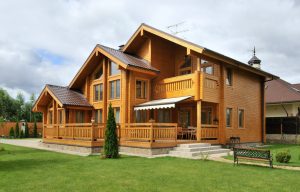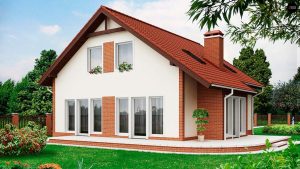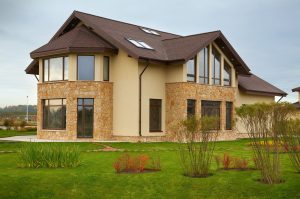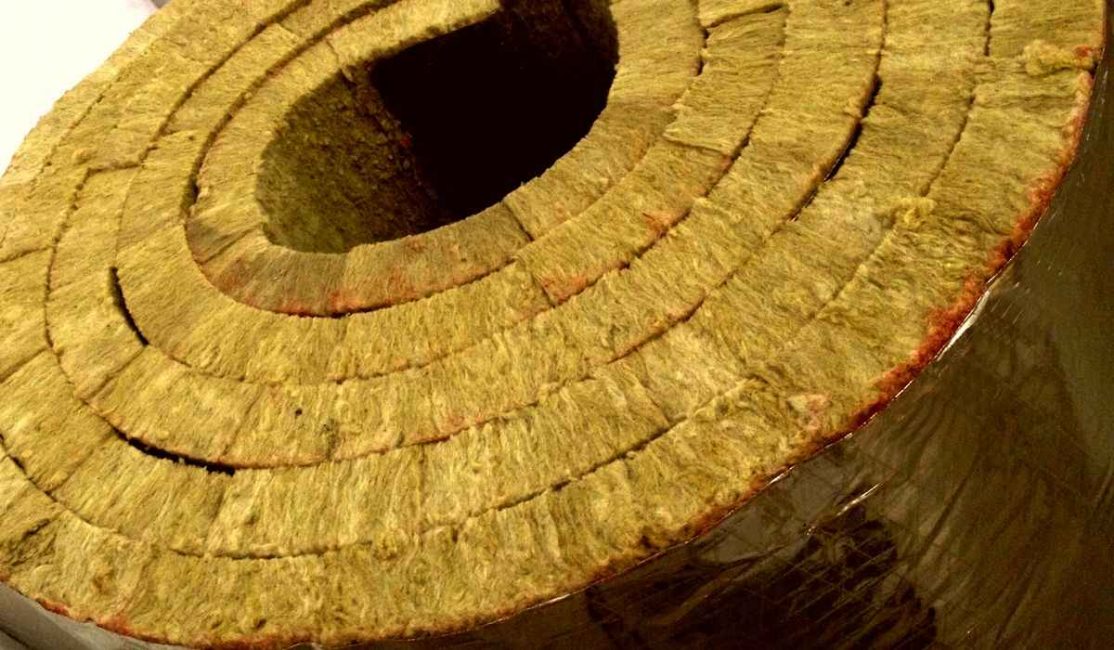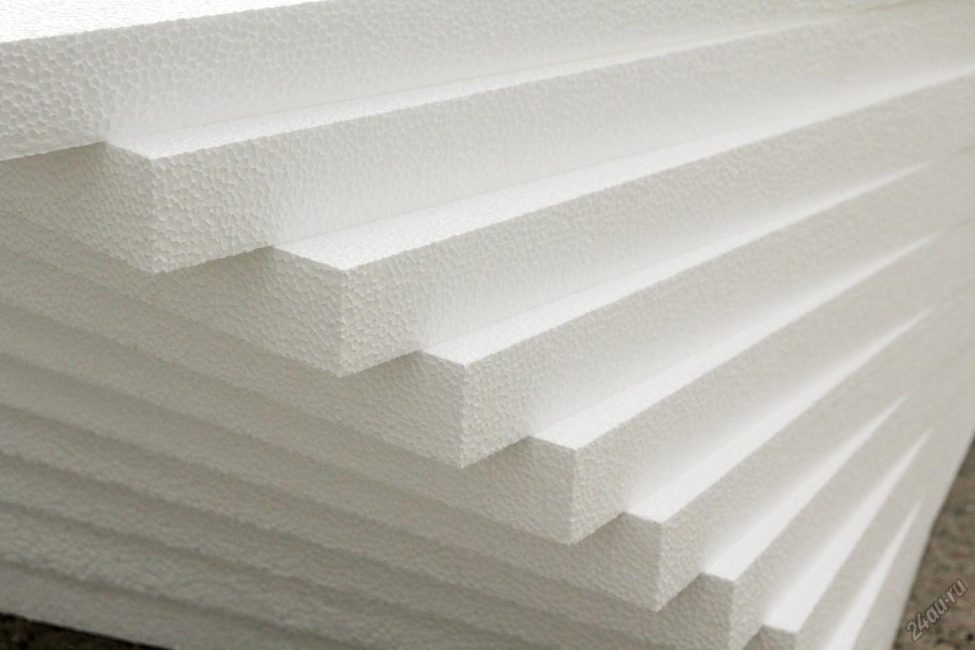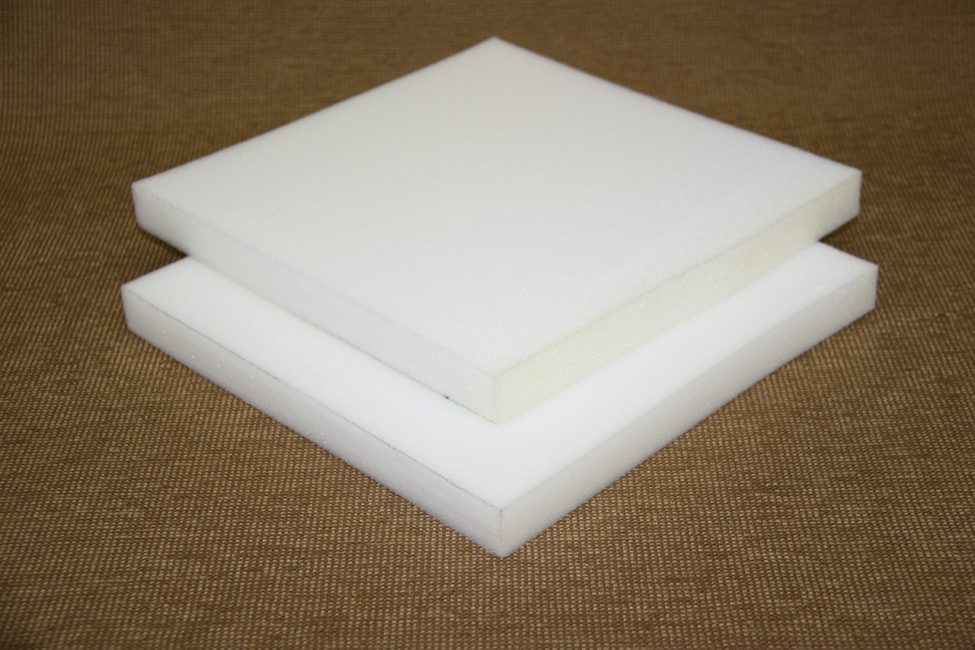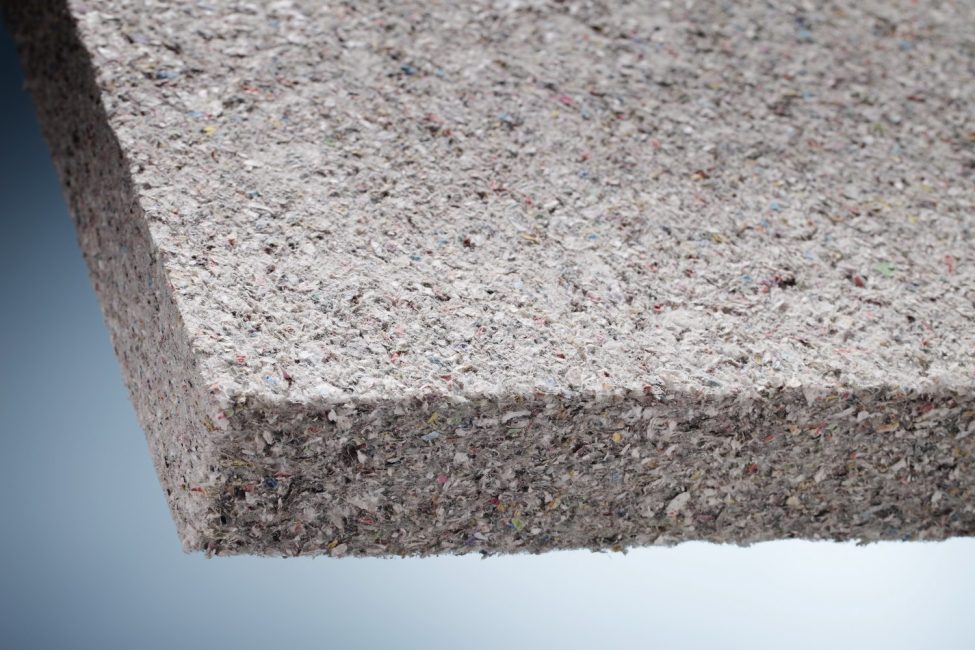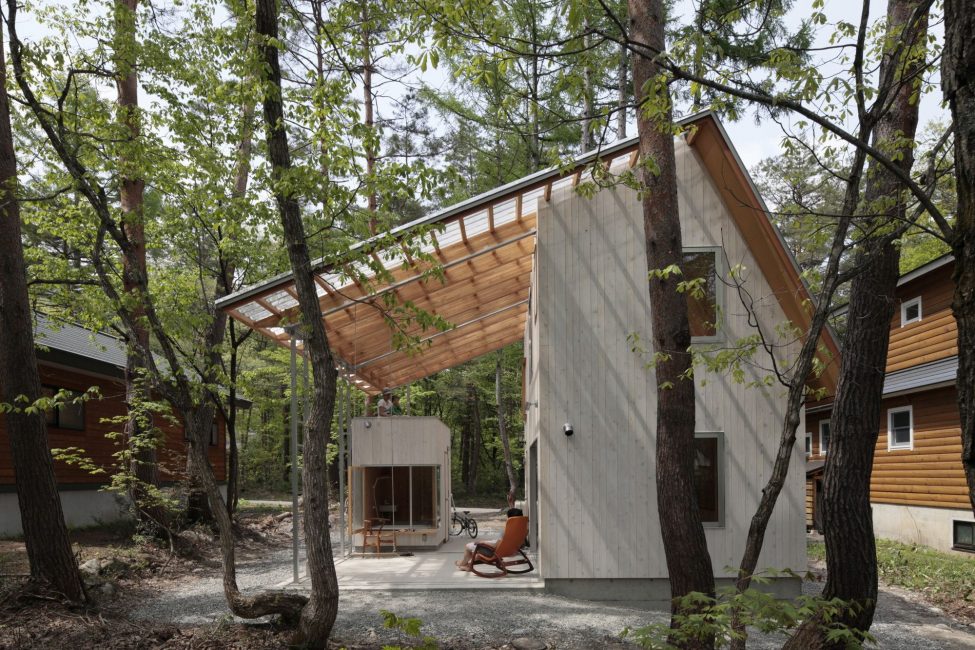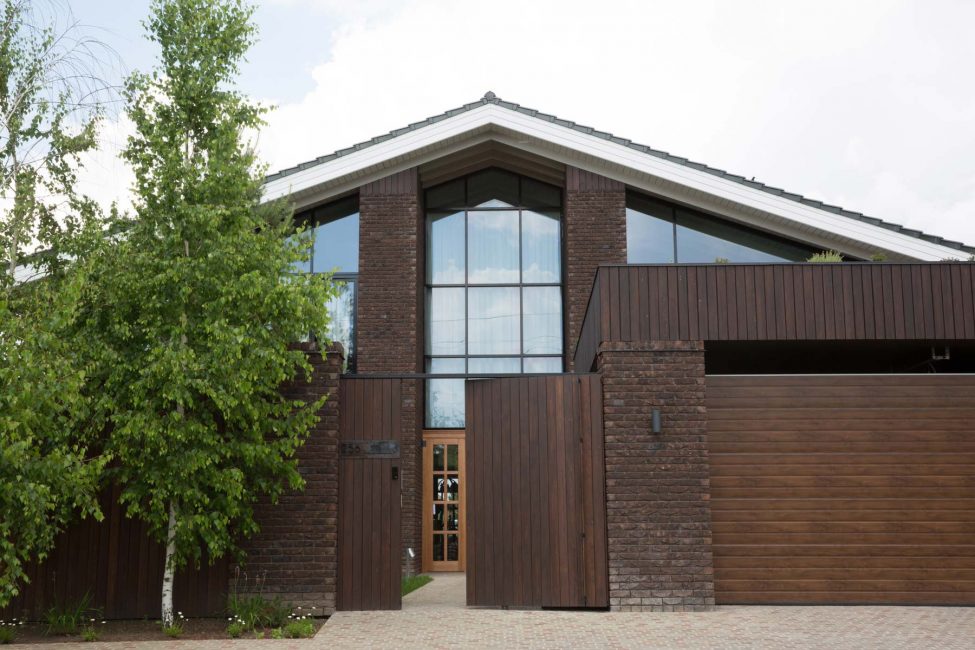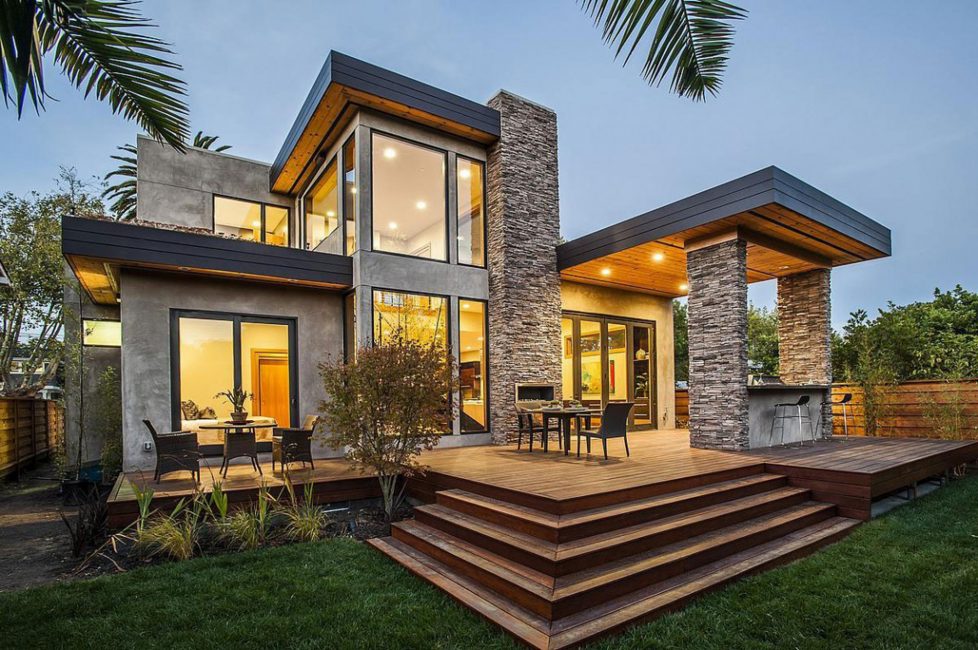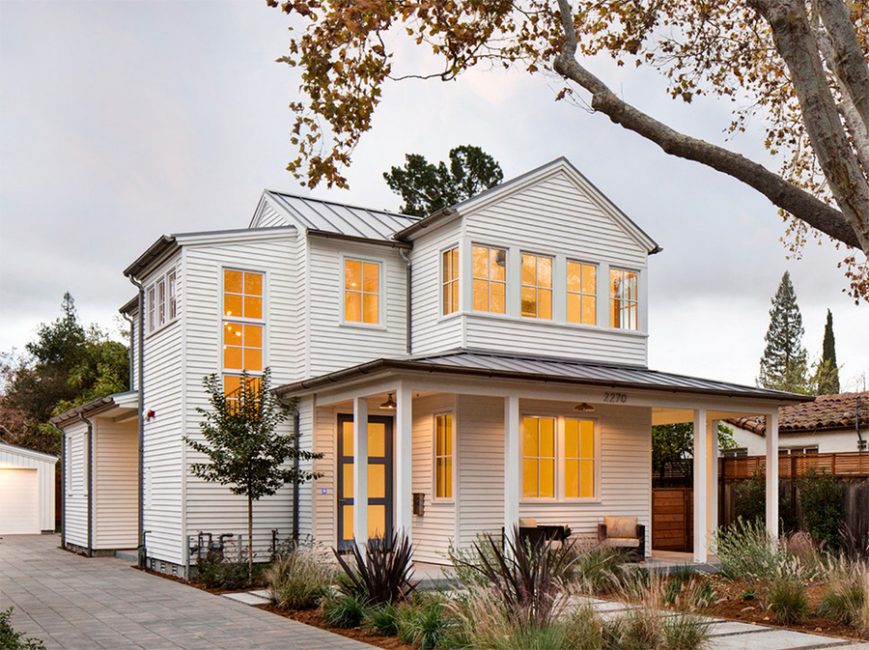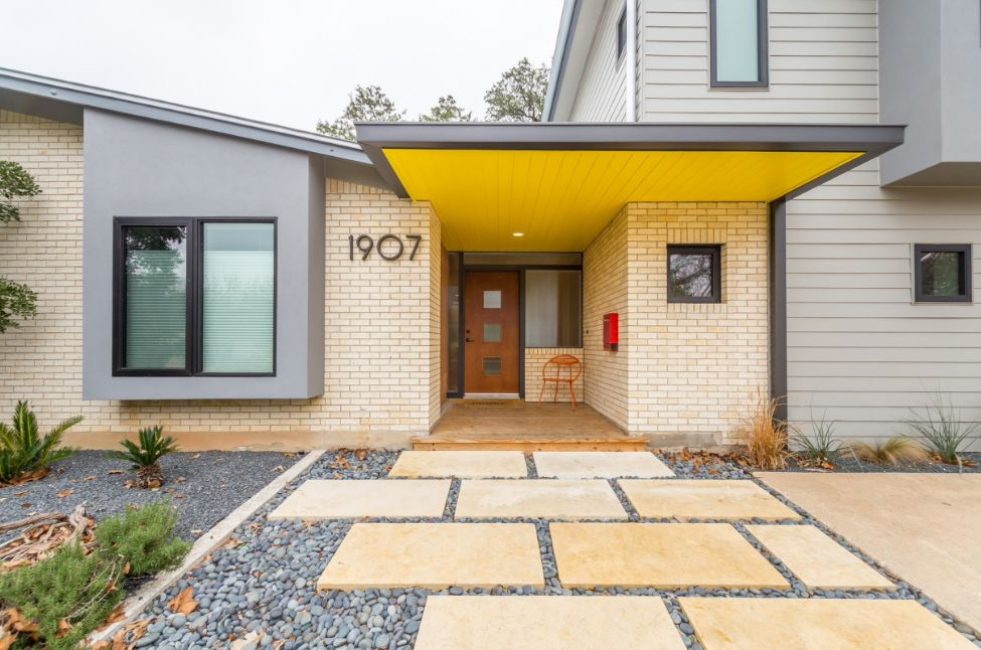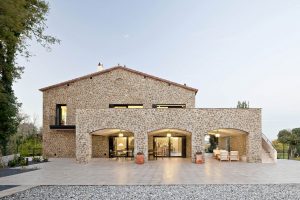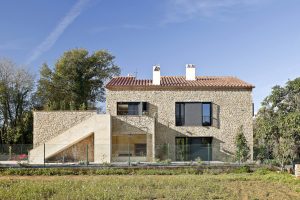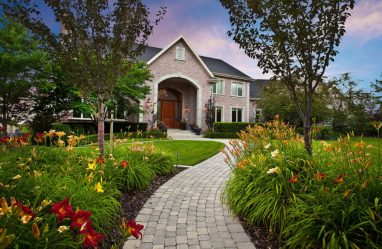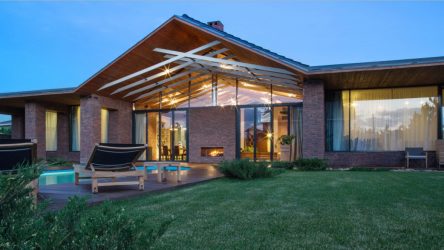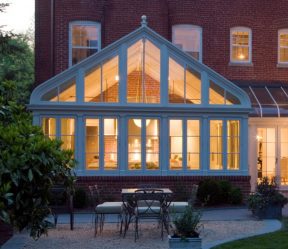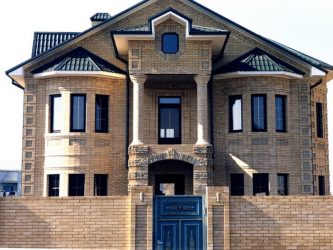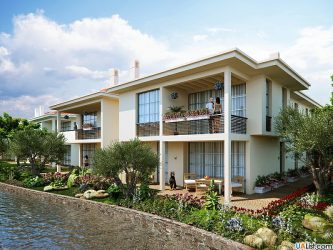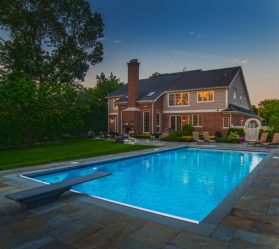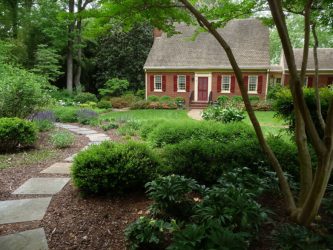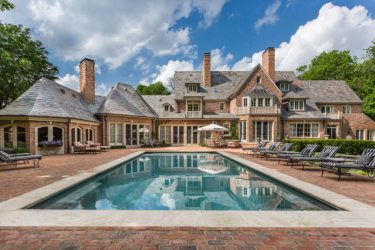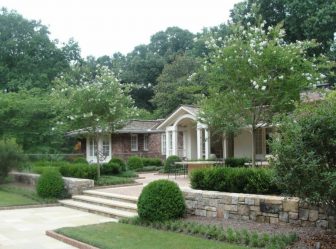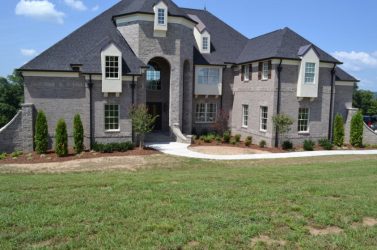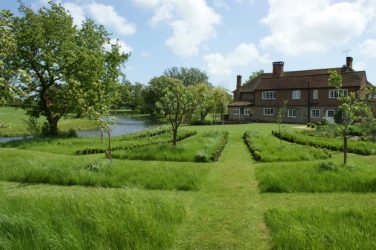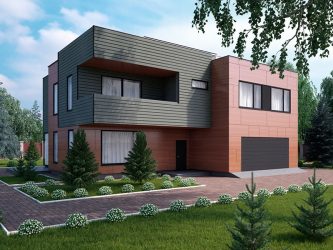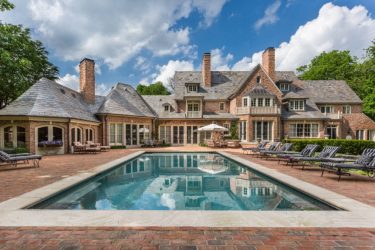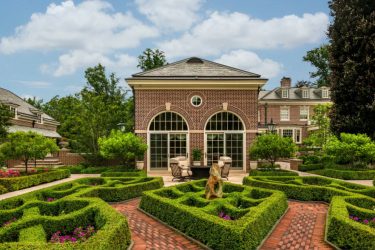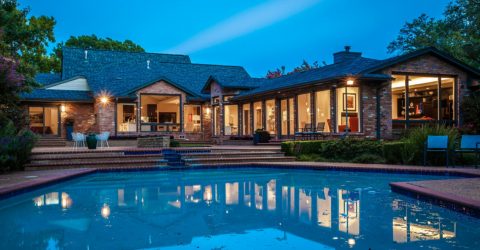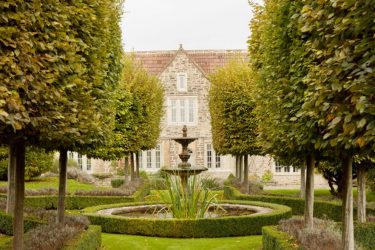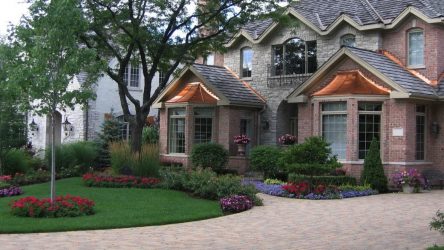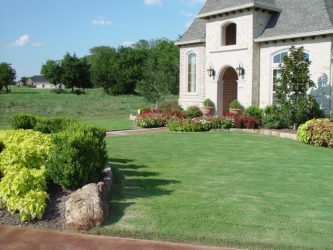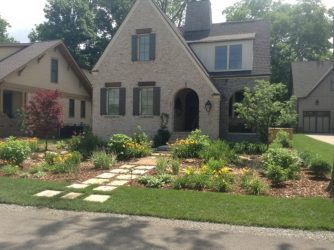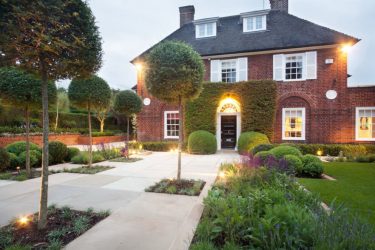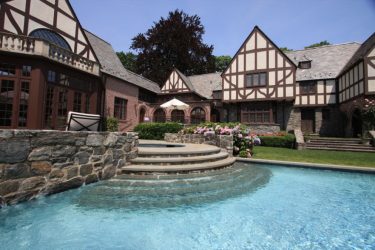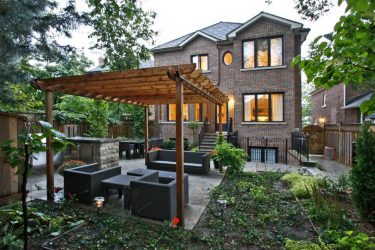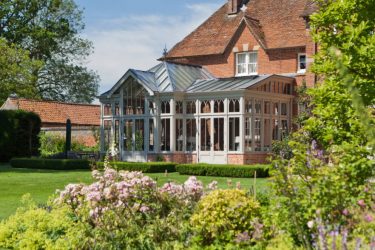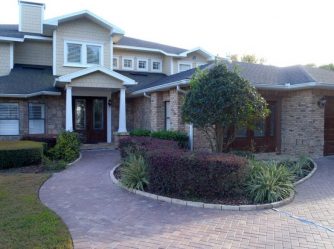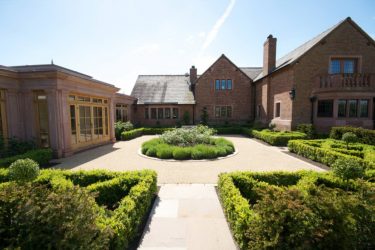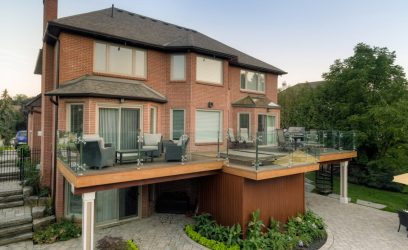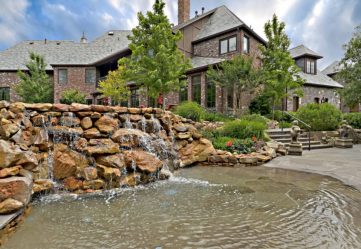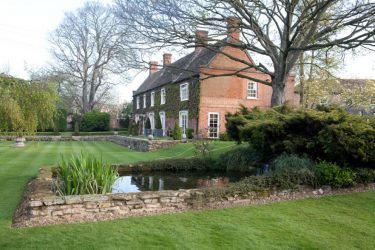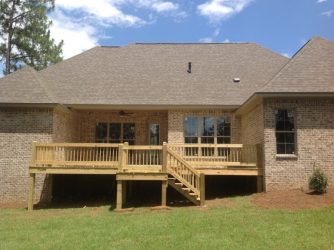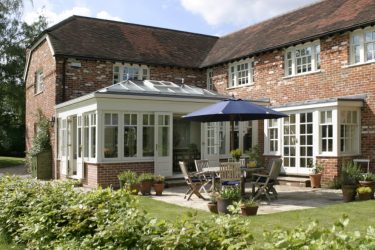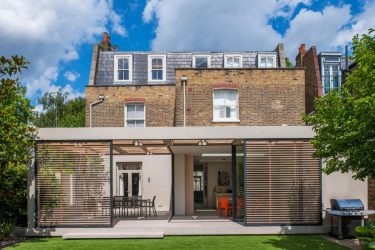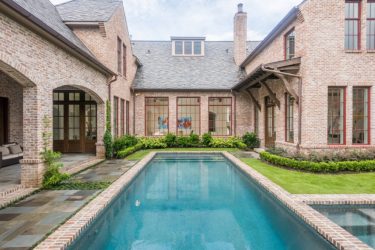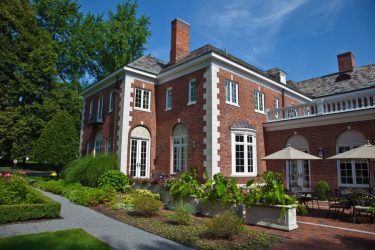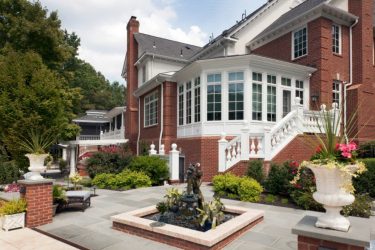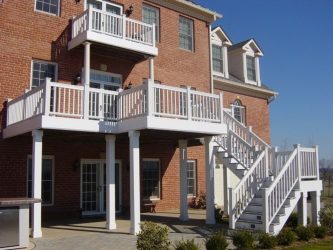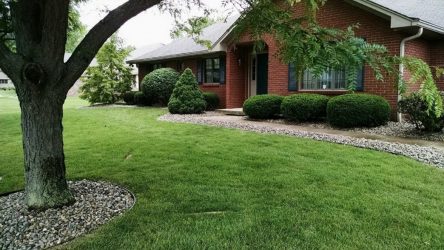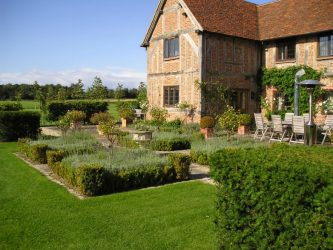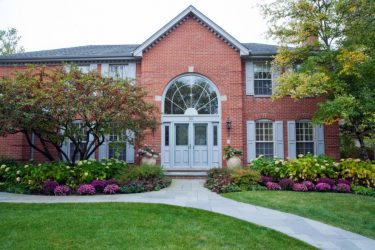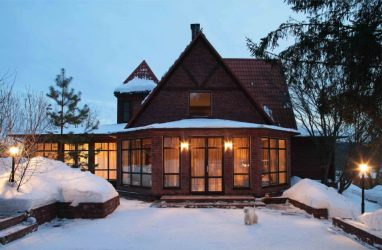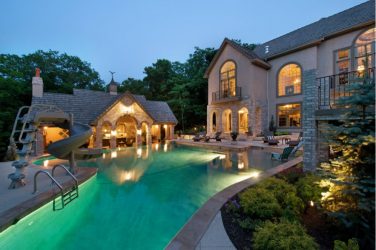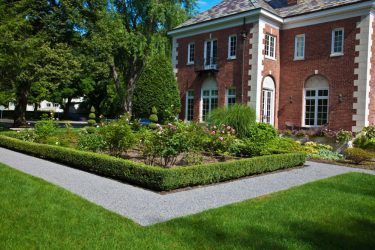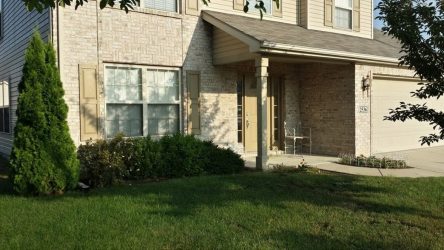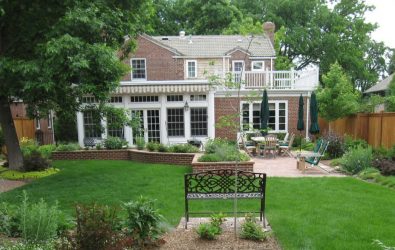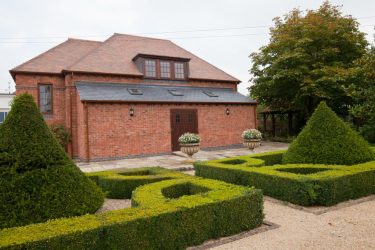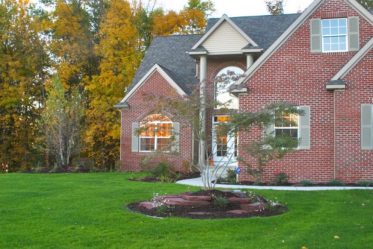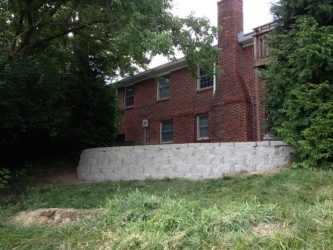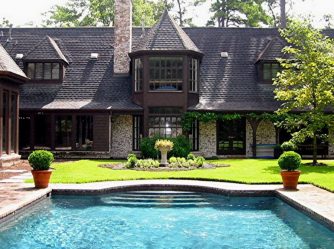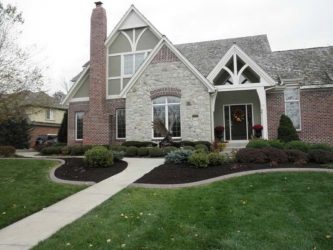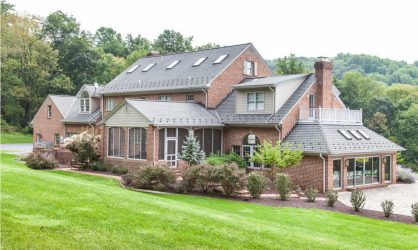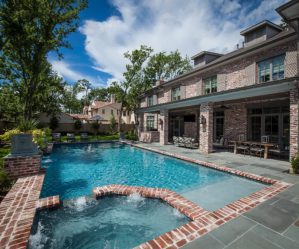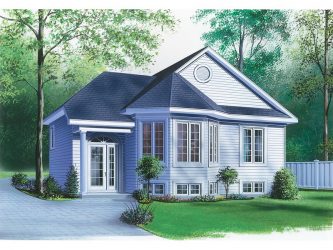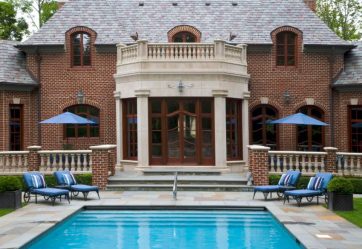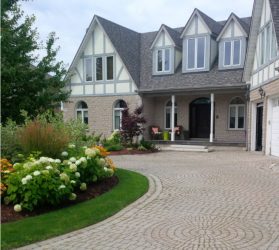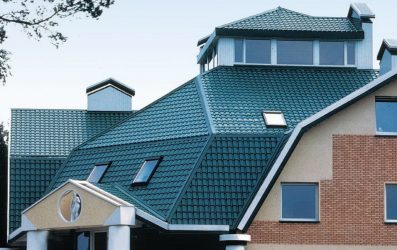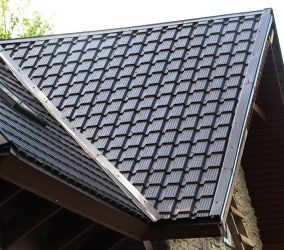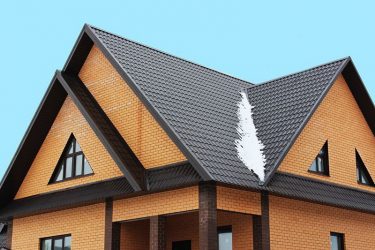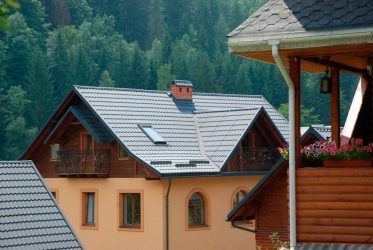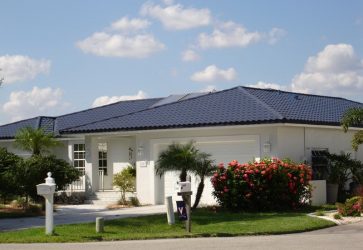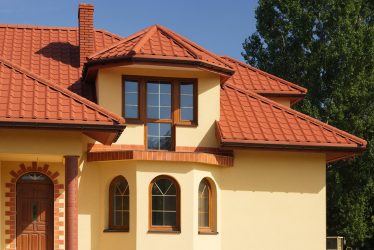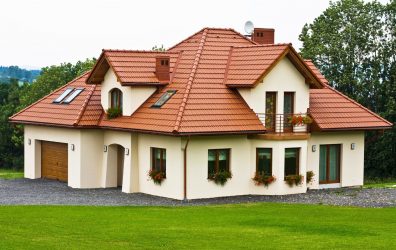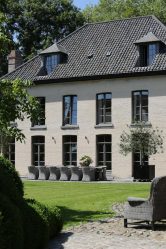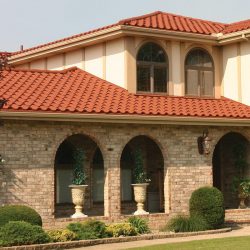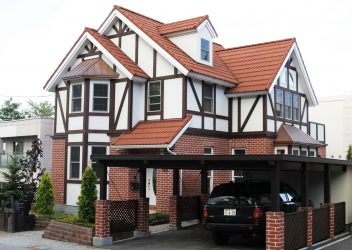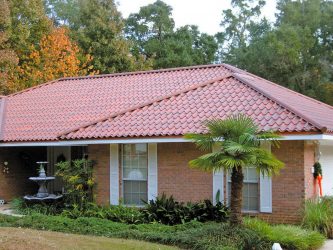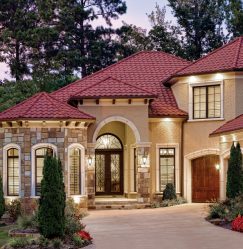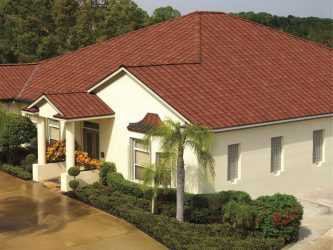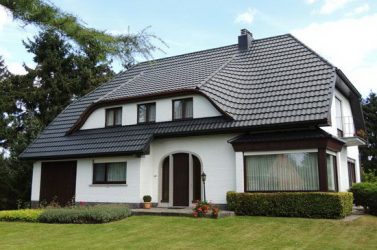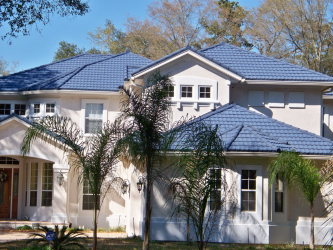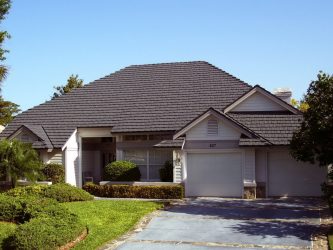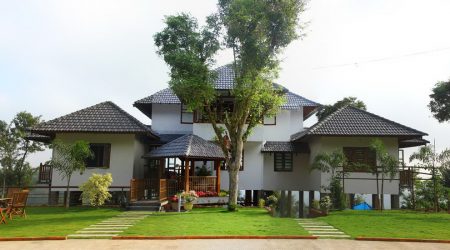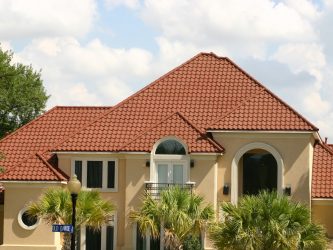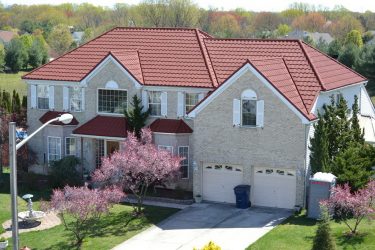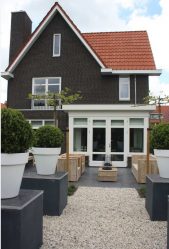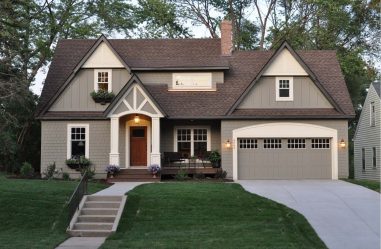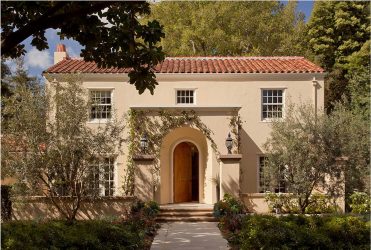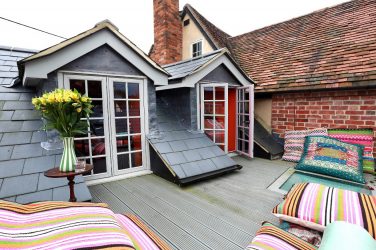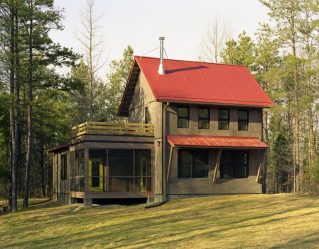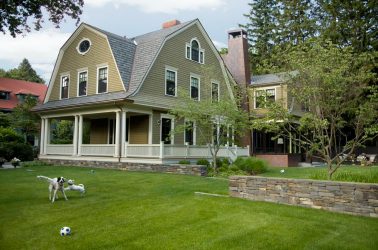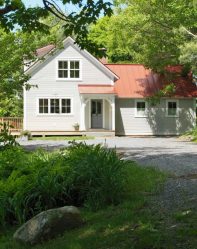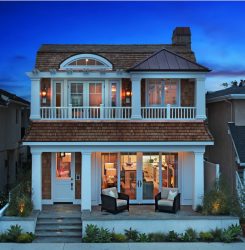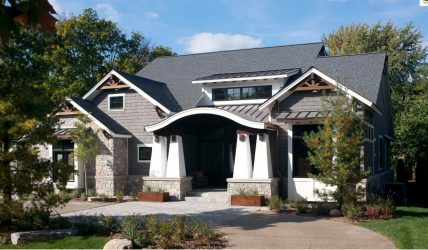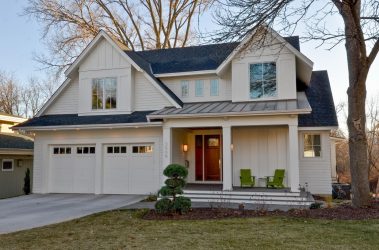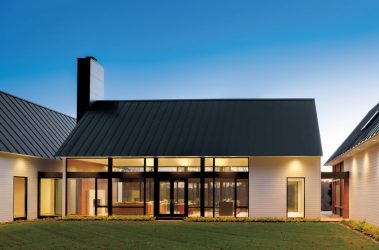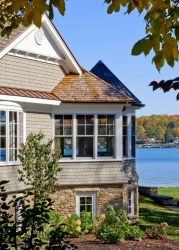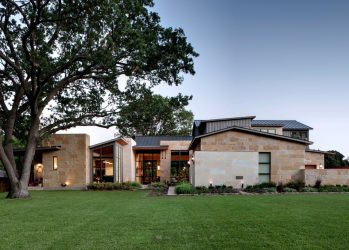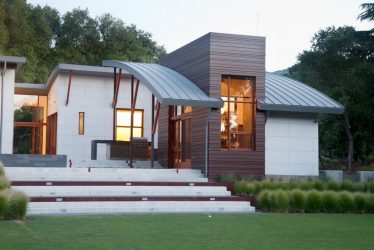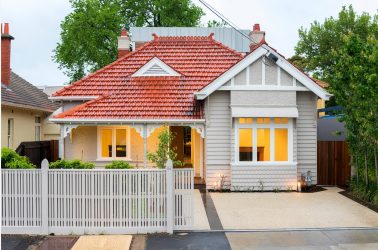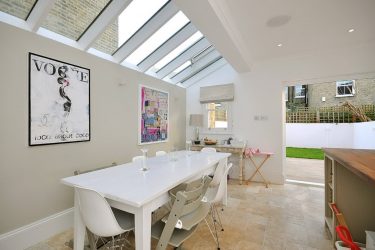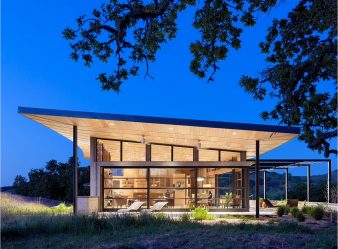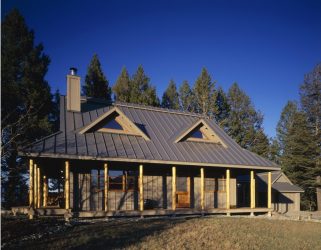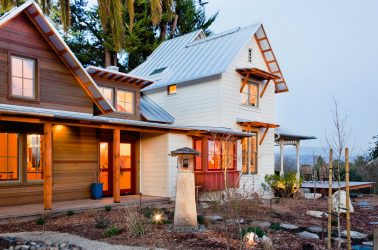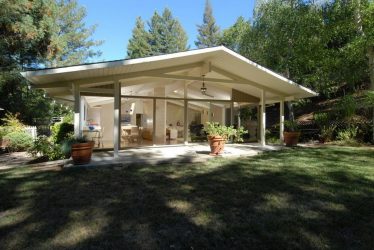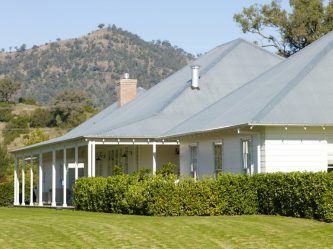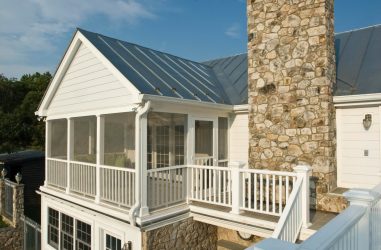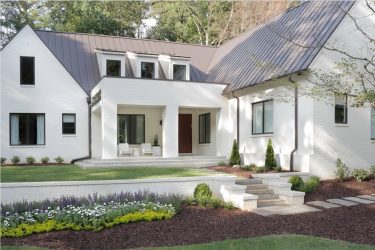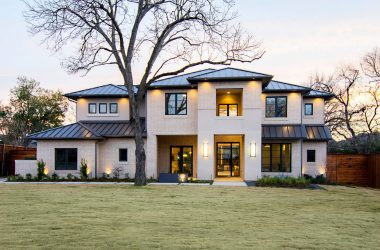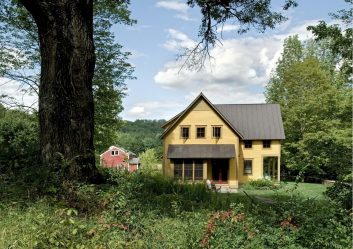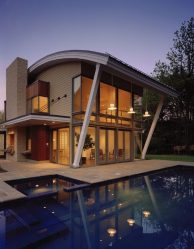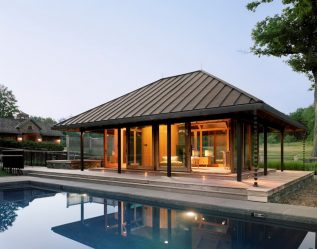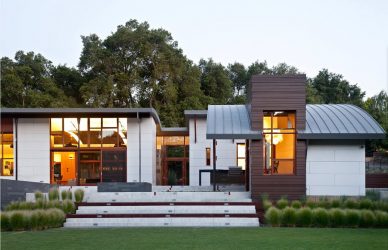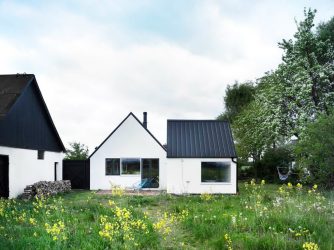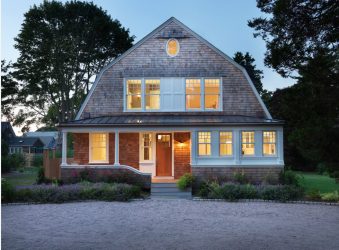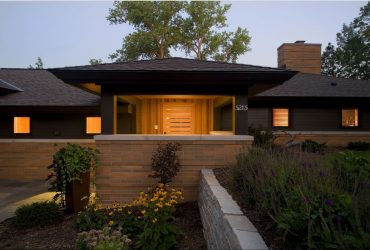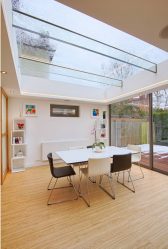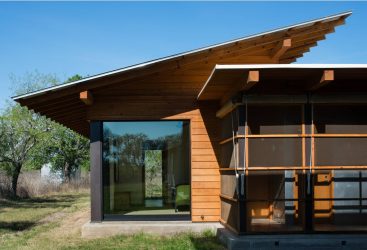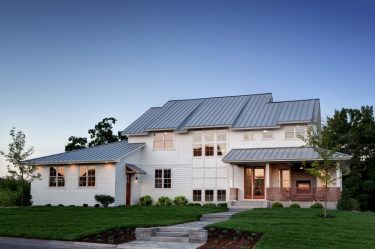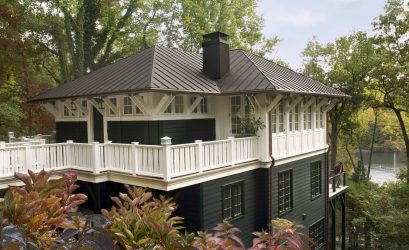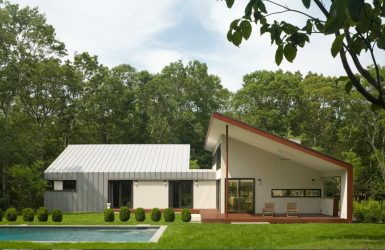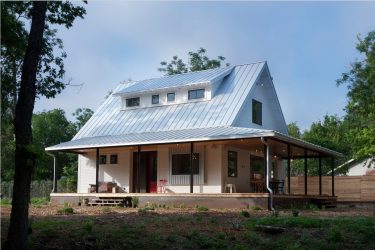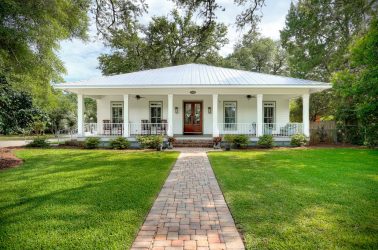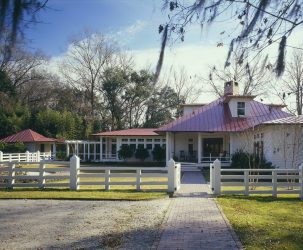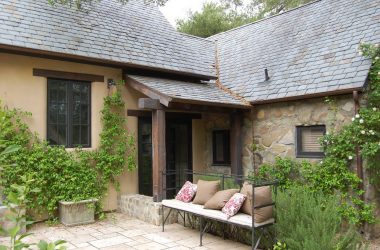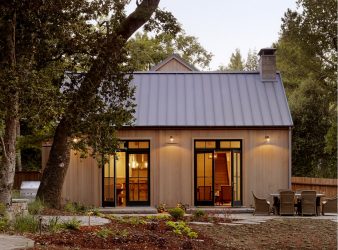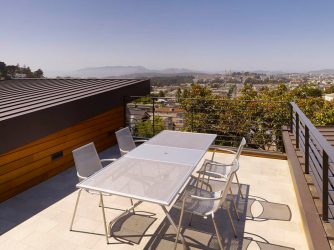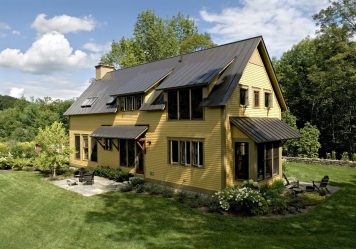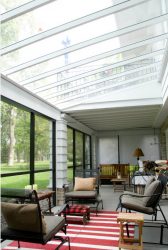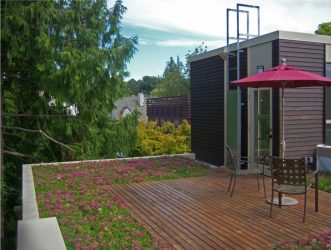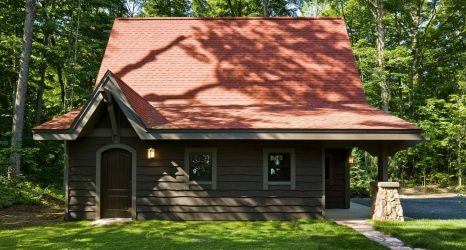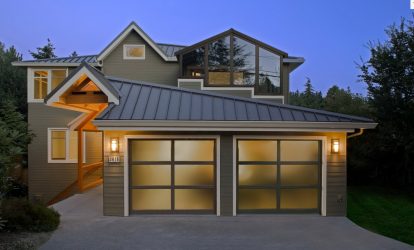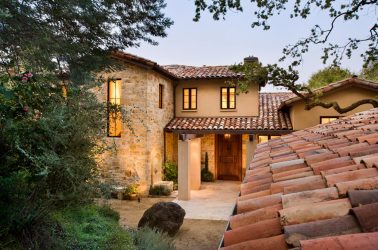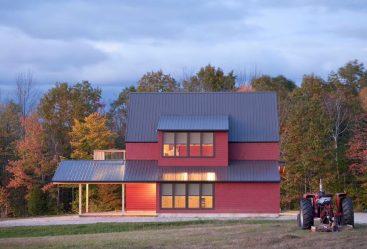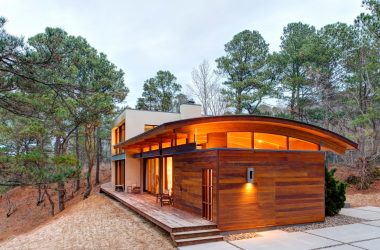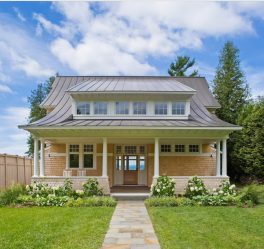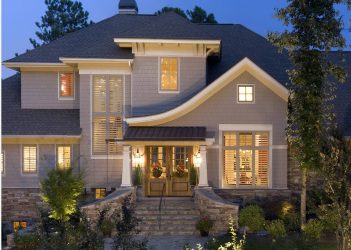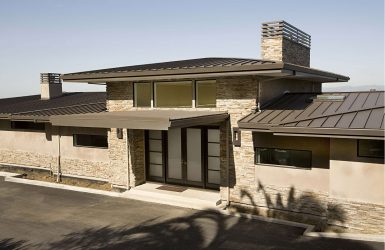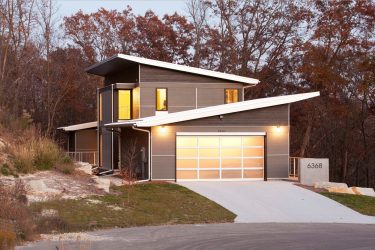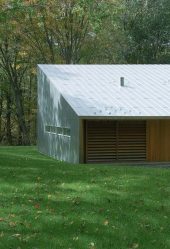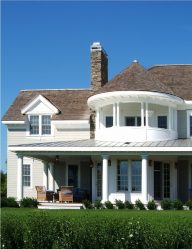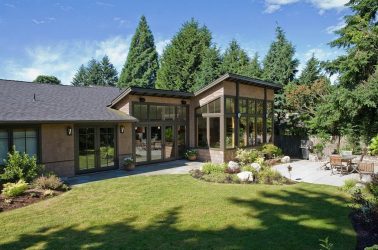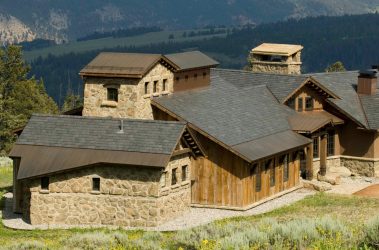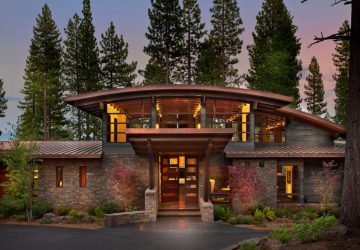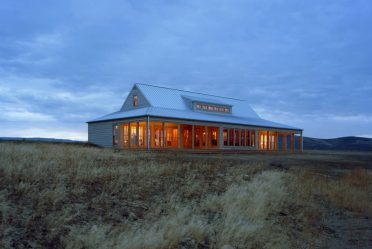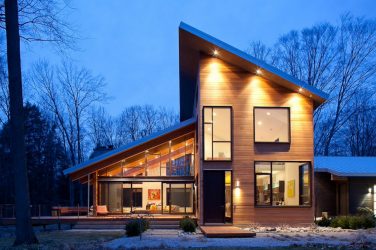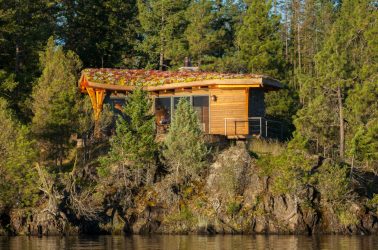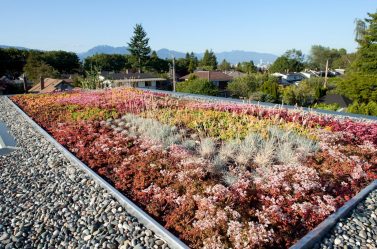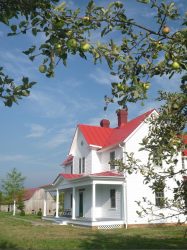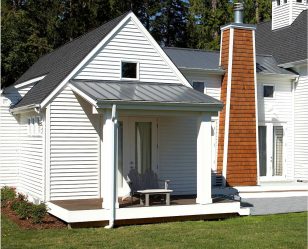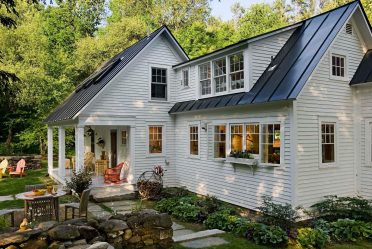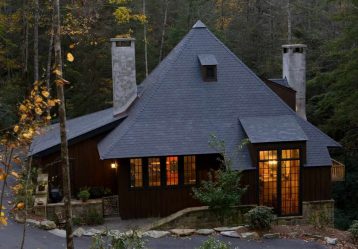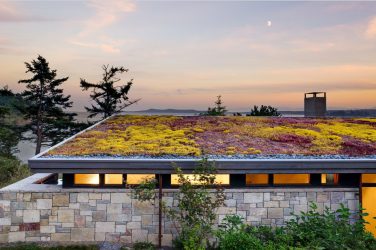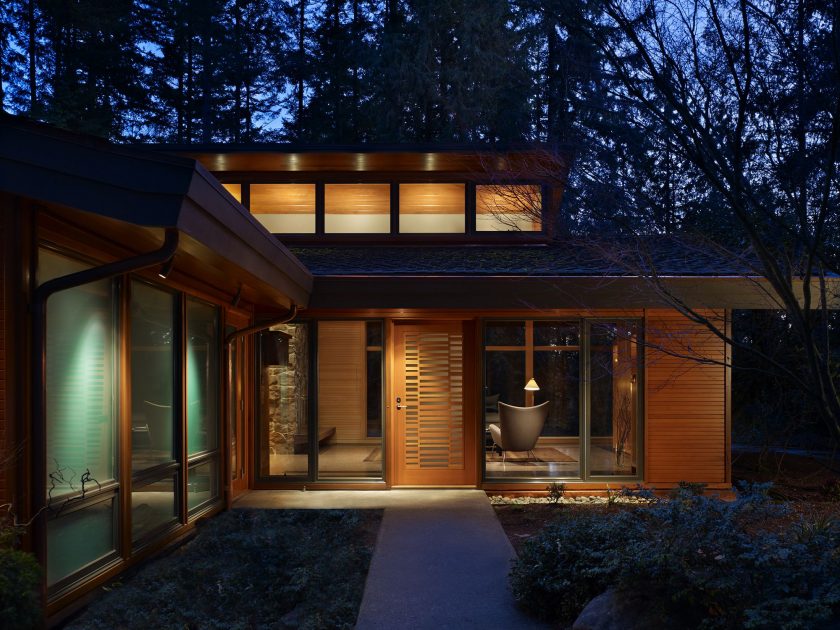
The roof is also considered important in the structure of the house, as the base and walls. It refers to the number of supporting structures, therefore it must meet a number of requirements: to be strong, reliable, durable, well-insulated, have good thermal and sound insulation. Which roof to choose - the prerogative of the failing homeowner. Here the main thing is not to make a mistake in choosing. The roof must also comply with, as the form, be fireproof.
Content:
To make it easier to fulfill these requirements, before creating a project for a house, it is necessary to select a form in advance, calculate the height, and select the appropriate materials for its construction.
What forms are there?
Forms of roofing there are several types. The choice should be based on design features:
- Single bar. One roofing plane resting on the two outer walls of unequal height. Used for outbuildings (shed) and on garages.
- Gable. It has 2 planes, which, as in the first case, rely on 2 external wall structures, but of equal height. Planes are projected at a certain angle relative to each other.
- Hip. It has slopes from the front side in the form of a triangle. The side walls are also similar to the triangle only truncated or trapezoid.
- Half-hardened. Consists of 2 ramps. Surfaces on the front side have the shape of a triangle.
- Broken. Very complex roof model. Below the slopes are triangular, at the top they are connected, and always at an obtuse angle.
- Hip. Also not without complications. This is a quadrangular design with 4 slopes of the same size.
- Cross shaped. Used when the house has a complex shape. To do the calculations and the project in this type must design engineer. This is explained by the fact that the cruciform shape of the roof provides for the calculation and installation of the chafing machine. It is important to place them in the design. Otherwise, the course can not be avoided.
There are many forms of roofs. Here you need to learn not only to choose the form, but also correctly calculate the design of the roof.Only then the roof will perform the functions assigned to it.
return to menu ↑Why do we need to calculate the height and how to do it correctly?
The roof is the part of the house that is most often exposed to the effects of weather. With an incorrectly selected angle of inclination, and accordingly height, the risks are due to the impact of strong winds and precipitation, its integrity will be compromised.. We'll have to repair the roof to fix the problems - this is at best. At worst, you have to build it from scratch.
return to menu ↑The role of height indicators
You can not neglect the standards when creating a project. The reliability of the construction and the health of those who will live there depend on it. Below are a number of arguments that can completely confirm the correctness of the above and the significance of the correct calculation of the height of the roof for the structure houses:
- Reliability and durability. Properly calculated and selected height will allow the roof to be resistant to the effects of external, weather effects, resistance to high loads, for example, roofing, insulation.
- Aesthetics. Appearance plays an important role. If its height does not match the design of the house, then such a roof will not look aesthetically pleasing.
- Convenience. With the right height you can build an attic.
The highest point is called the ridge. This is the point where all inclined planes of the roof connect. If its height is chosen incorrectly, then there is a risk that the roof will not serve the period for which the master of the house has been calculated. The parameters of the height of the ridge must strictly comply with the technological process.
How to calculate the height of the roof?
Video tutorial on finding
What determines the height of the ridge?
An important parameter in the calculation is the slope angle. There is a list of factors on which it is based mainly on atmospheric effects.:
- wind, if in the region they run wild often, then the slope angle should be 10-20 degrees;
- precipitation in areas where they fall abundantly above 45 degrees;
- snow - with very snowy winters, the angle of inclination may be similar to the previous point.
Choice of height by type of roof
Here, height calculations are made taking into account the type of coverage:
- If the materials for the roof have a lot of piece elements, the angle of inclination should be chosen as much as possible.
- If the roof structure is low, the joints should be kept to a minimum.
- For very heavy roofing masses, the largest inclination angle is chosen so that the weight can be evenly distributed over the entire surface.
Calculation parameters taking into account the width of the building
Here, the cross section of the structure is represented as an equilateral triangle. Where the height parameter is the leg. Further calculation is made as follows:
- determined by the tangent in relation to the selected angle of the slope;
- Knowing the width of the box at home and one of the sides adjacent to the corner, the value is calculated by dividing the index by 2;
- the result is substituted into the calculation formula a = tg a × b.
According to this formula, you can calculate the height of the ridge without errors. Just be sure to include in the calculation of the width of the house. The more it is, the higher you need to do the angle of the slope.
return to menu ↑Roofing materials. What to do bias when choosing?
Professionals identify the following criteria:
- Colour;
- forms;
- specific gravity;
- cost;
- price of installation work;
- reliability and strength.
Buying roofing need to pay attention to weight. For example, compare two popular types - metal and ceramic tiles. The latter is heavier than the first time at 10.And it plays a significant role in the design of rafters.
- combination with fronted;
- the price of the roofing material was not too small;
- the mass should not exceed the allowable, otherwise the walls can not stand;
- comply with established standards.
What materials can I use?
The list of coatings for the arrangement of roofs is quite wide. Each has its primary characteristics and disadvantages.
Roofing materials
What to choose?
Metal tile
Most popular over the years:
- endowed with high rates of mechanical stress;
- resistant to moisture;
- does not deteriorate when exposed to atmospheric factors;
- well protects the house from ultraviolet radiation;
- the proportion is small.
Due to its low weight, it can cover a variety of roof shapes. At the same time, the pressure on the foundation and walls will remain low, which means that the strength of the house will be high.
return to menu ↑Ceramic tiles
Produced for a long time - more than 100 years. Significantly improves the appearance of the facade in comparison with the clay counterpart. Considered:
- Reliable coating.
- It has a long operational life.
- It is characterized by high strength.
- Unaffected by moisture.
- Provides absolute UV protection.
With all the preferential characteristics, it has several disadvantages:
- high cost;
- great mass.
Ondulin
Enjoys reputation. It takes positions in quality and consumer demand:
- reliable;
- moisture resistant;
- lasting;
- protects against UV;
- tolerates high loads;
- resistant to mechanical stress;
- endowed with waterproofing properties;
- fireproof;
- does not corrode;
- has good flexibility.
It is installed on a flooring installed from lath strips.
return to menu ↑Slate
The cheapest roofing material:
- service life - 40 years or more;
- moisture resistant;
- withstands mechanical stress;
- Well withstands high loads, for example, the snow layer.
Disadvantages:
- In the process of long-term operation, its edges begin to crumble;
- In places where it is constantly shaded a lichen begins to appear.
Decking
Roofers often work with this material referring to the fact that it is reliable and very durable. In comparison with a metal tile it has wider sheets, and also:
- small proportion;
- high strength;
- considered an environmentally friendly coating;
- has a wide selection of colors;
- You can install it in all weather conditions.
How to choose decking?
What to look for?
Disadvantages:
- it makes a lot of noise if it rains;
- for complex forms of the roof requires a lot of material;
- subject to corrosion during operation;
- drill holes or cuts need additional processing;
- requires hydrolayer to prevent condensation;
- requires additional insulation.
Shingles
Seamless coating based on fiberglass impregnated with bitumen. The outer part is treated with basalt, painted in different colors:
- has high strength;
- endowed with good sound and heat insulation properties;
- provides excellent sealing.
From this list you can choose any roofing material. Which one will be the best to choose you.
return to menu ↑The choice of insulation - which is better?
Choosing a good heater, refer not only to the cost price, but also to the technical, operational characteristics. And also on the complexity of installation. Laying insulation can be done personally, although in some cases you will need to use special equipment. Criteria for choosing a good insulation:
- thermal conductivity coefficient - the smaller it is, the better;
- moisture resistance;
- lifetime;
- stability of form and appearance;
- heat insulator weight;
- resistance to low temperature;
- sound insulation properties;
- environmental friendliness.
The list of errors that are allowed during installation, as a result of which the insulation does not have the effect:
- Savings on the cost of the material, and therefore on its quality should be trusted proven manufacturers.
- Insufficient thickness of the insulating layer.
- Laying technology is broken - waterproofing or vapor barrier is poorly laid, there are no gaps in the pit-shaped roof pie at the joints.
Choosing a good insulation from all possible
Among the most commonly used are:
return to menu ↑Mineral wool
It has a fibrous structure made of alloys of rocks. One of the most effective. On sale comes in roll form or in the form of plates.
Primary characteristics:
- high coefficient of thermal insulation;
- cost;
- the mineral wool does not burn;
- environmental friendliness;
- ease of installation;
- biostability - not subjected to putrefactive phenomena, it will not be damaged by rodents or insects;
- has good vapor permeability;
- sound insulation coefficient is high;
- does not lose shape.
Roof insulation
What is needed for this?
When installing mineral wool insulation, it is imperative to provide a vapor barrier and waterproofing layers. And also take care of the organization of ventilation gaps. This will prevent condensation. If this is not done, then the rafters will eventually rot.
return to menu ↑Glass wool
According to its thermal insulation properties close to the mineral wool, it has been used as a heat insulator for a long time. It is made of fused glass. It goes on sale in roll form, characterized as a good, eco-friendly and non-combustible material.
Styrofoam
He also used foam very often in wall insulation and as a heat insulator for the roof:
- It is characterized as a material with high thermal insulation properties.
- Resistant to moisture.
- Does not absorb steam, so it can be laid directly on the waterproofing, the air gap does not need to organize.
When laying foam in the pitched forms of the roof it is necessary to make sure that the edges of the material fit tightly to it. Seams after installation need to be treated with foam.
The material is combustible and vapor-proof, which means that it cannot be used in the insulation of flat roofs.
Polyurethane foam
Also good for roof insulation. Its list of advantages includes:
- low thermal conductivity;
- small weight;
- good sound insulation;
- biostability;
- good waterproofing properties.
The material is endowed with sufficient rigidity. Well cut, drilled. Does not lose forms in the process of service.
Ecowool
Made from paper. Treats environmentally friendly roofing heaters. Endowed with good sound and heat insulation qualities. In order for the material not to be combustible and not exposed to damage from rodents and insects, ecowool manufacturers treat it with defenseless substances and antipyrine.
Treats the easiest and cheapest types of heaters. Sold in liquid form. when using it as insulation for the roof (between the rafters), it is necessary to create some closed boxes. Ecowool is blown into them so that it not only fills the space, but all sorts of cracks. Disadvantages - use in the installation work of special equipment.
There are other ways to insulate the roof.
return to menu ↑Painting the roof - the nuances, ways, features
Roof cover with different materials depends on this feature of the work and the appropriateness of painting:
Paint the roof in two ways - manual or machine. Before the procedure should follow the following requirements:
- Do not paint the roof in bad weather, especially during rain. This is best done in the spring in April or May, in the fall in September or October. During these periods, the coloring layer will have the best adhesion, which means it will last a long time.
- In the summer it is not recommended to paint at all because of the heat.
- Prokrasku exercise in non-slip and non-scratching surface of the shoe.
- If the work is performed at high altitude, you need to take care of your own safety, tying yourself with a rope to the rafters or the beam.
- It is not recommended to cling the insurance rope to the chimney - it is unreliable, it can not support the weight of the body.
How many layers should the roof be painted on?
In order for the ink layer to be durable and look appropriate, at least 2 coats of paint should be applied:
- At the first application it is necessary to take 700 grams of varnish on each kilogram of paintwork, mix and then paint.
- When painting again for each kilogram of paint you need to take already 5,000 grams of drying oil.
Application technology - or how much time to wait between the first and second painting:
- Overlaying the first layer, you need to wait a week so that it dries well.
- The second layer will be 3 days longer to dry, that is, the total is 10 days.
- If you decide to apply the 3rd layer, then you need to use and wait just such a time.
How to choose a color for the roof and facade?
White the color of the facade has long gone out of fashion. He was replaced by more interesting solutions. They pollute less and please the eye more. This approach is fraught with the need to choose not a monotonous, but a color design of the roof. It must be in harmony with the walls and the landscape.
You can draw your house on paper, coloring in the color scheme that you prefer. And having created a model not on a computer, you can consider your version in a three-dimensional image, if you wish, recreate around it and your landscape. It will be the most correct and reliable option to see how the house will look from the outside.
You can order a turnkey project ready, but this service is not available to everyone. Consider all possible options in another way - by creating a template. To do this, a flat projection of your facade needs to be translated into tracing paper. (you can use plastic wrap), and then using the color substitution method, choose a shade, manufacturer.
Even if everything fits with the color, the chosen option will suit you in all respects, you don’t need to run and purchase all the coloring material. It is necessary to begin to paint a small patch of the facade and roof in the chosen colors.
The assessment of the final shade is affected by:
- surface texture;
- type of foundation;
- lighting.
Look at them at different times of day and weather conditions:
- in the morning before sunrise;
- a day in good light;
- in the evening, when only the lights are lit;
- on a cloudy day.
The disadvantage of this selection method is that it can test a limited number of colors.
return to menu ↑Features colored roofing
Multi-colored roof can affect the visual perception of the house as a whole. It can even change its configuration - increasing in size, albeit visually, or, conversely, reduce, hide not too obvious flaws, adjusting the level of insolation. Begs, based on all that has been said, so what should we expect from a color that you liked more than others?
- The roof in the dark color is very warm in the heat, absorbs the light. Such a decision will be justified in the northern regions. In the south, use a lighter palette.
- Bright saturated colors are picturesque. Only they will start to burn out very soon. Such variations are used only in the roof of simple architectural forms. Where there is a large number of small items.
- The white roof is not recommended because it will eventually become stained with yellow and will have an unpresentable appearance.
- Gray - the most practical, but boring. Make sure that the facade with a gray roof was extraordinary.
What colors can paint the walls of the house?
The choice of colors for painting the walls of the facade from the street is dominated by those that are directly related to naturalness:
They can be easily combined with each other. These facades will look cozy and presentable. A good option - the yellow-sunny walls with dark doors and windows.
Roof painting
Technology work
In red Roofing is not only the roof, they are often used in the painting of the facade. But on the walls its saturation is not as bright as on the roof - it resembles brickwork. If you revet the facade of clinker tiles, and the roof, window and the doors paint in a bright color scheme, then the view of the house will be complete.
From fashion trends - the use of blue. It is good to combine it with white, gray, beige. If the walls are painted in blue, the doors with windows are white, and the roof is gray, then you can hardly find an elegant appearance in the area.
Violet, black or dark blue facade is not nonsense. But we warn you, this solution is not given to everyone. This is quite a bold decision in the design of facades. If you choose a dark background of the walls, the roof and other details need to be made light.
return to menu ↑If you are afraid to make a mistake
In order not to be mistaken in the selection of colors you need to remember this.
Derivatives of the same color are always combined with each other. If, for example, you make the facade in warm colors, make the roof in the same warmth. If you use a cold palette for it, then the appearance will be, to put it mildly, absurd.
Large surfaces such as the walls of the house and the roof are also not desirable to be painted in solid dark shades. Appearance will be overly depressing. Much more fun will look option where light colors will be shaded small details.
The individuality of the structure can be given if the background (walls) is dark, the windows and doors are light, the basement is brighter and more saturated. In this version of the three colors is enough.
It is very important, when selecting a particular color scheme, to ensure that it matches the architecture of the building. And in addition, you need to focus on the landscape surrounding your site.
